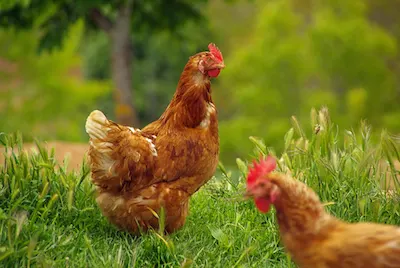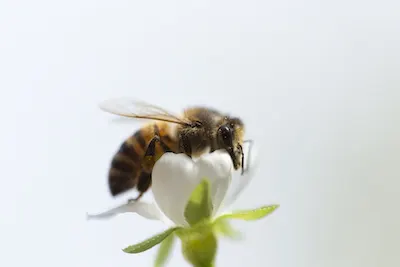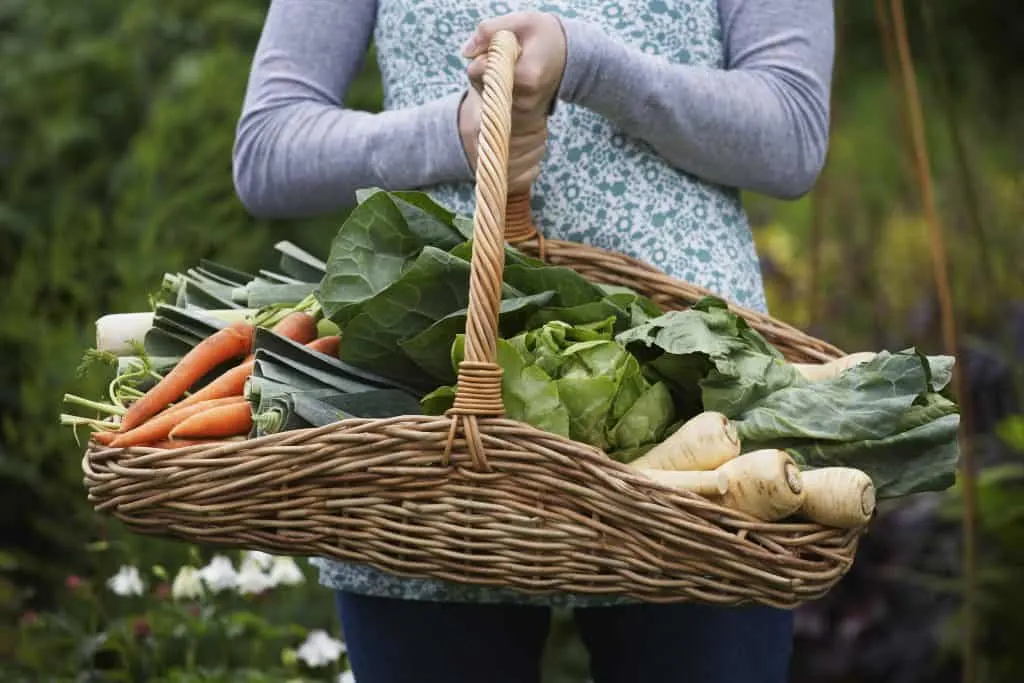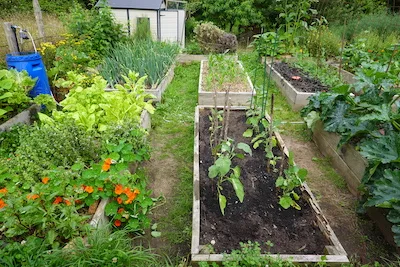How to Homestead on 1 Acre
If you think you need tons and tons acreage to have a homestead, think again! With these 1-acre homestead layout ideas, you’ll see how you can create a thriving and sustainable homestead on a small amount of property.
Picture this: a lush and thriving oasis where your veggies, livestock, and fruit trees coexist harmoniously with your cozy little abode. It’s not just a dream — with thoughtful planning and a touch of creativity, you can turn your 1-acre plot into a self-sufficient haven.
Whether you’re just starting out on your homesteading journey or you’re looking to optimize your existing space, this post is packed with ideas and inspiration to help you make the most of every square inch. So, let’s roll up our sleeves and get ready to discover how to create a successful homestead on just one acre.
What Can You Do on a 1-Acre Homestead?

Size alone won’t make or break a homestead. After all, many people create successful urban homesteads right in the backyard of their city home.
A well-planned 1-acre homestead can be a powerhouse of productivity and sustainability. The key is thoughtful planning and maximizing every inch of your space.
Related: Important Homesteading Skills to Start Learning Right Now
When you’re planning your small homestead, there are four main considerations you have to keep mind:
- Livestock
- Garden vegetables
- Fruit trees
- Other buildings
We’re going to take a closer look at each one of these to see what it takes to make them work on a homestead that’s around 1 acre in size.
Livestock for a 1-Acre Homestead
While you will have limitations on what type of livestock you can keep on a one-acre homestead, there are still plenty of options available. Before you choose what type of animals you’re going to have, it helps to nail down what you need from your livestock.
Will you be using livestock for meat? Are you interested in other consumables, such as eggs or milk? Once you have a better idea of how you’re going to use your livestock, it’s much easier to decide what to raise.
Also, keep in mind that it’s a good idea to choose animals that provide a variety of benefits so you’re making excellent use of your small space.
Chickens

Chickens are the classic homestead companions. These feathered friends are not only delightful to have around, but they also provide you with a daily dose of fresh eggs.
Since space is limited, opt for smaller breeds like Serama or Cubalaya. Be sure to create a cozy chicken coop with an attached run to give them room to scratch, peck, and lay eggs.
If you don’t want to incubate eggs or buy chicks, consider good broody hen breeds, such as Silkies or Cochins, which are known for hatching and rearing their own chicks.
Plus, don’t forget that you can use composted chicken manure to boost soil nutrients in your garden.
Quail
While chickens are great for small homesteads, quail are another good option growing in popularity. These birds are perfect for tiny spaces because you only need about one square foot per quail.
You can process quail for cooking, and they produce high-quality meat. They also lay delicious and nutritious eggs. Plus, when compared to chickens, they typically provide more eggs for the amount of food they need to eat.
Just remember that quail eggs are smaller than chicken eggs. It usually takes about 4 or 5 quail eggs to equal the size of 1 large chicken egg.
Plus, just like chicken manure, you can use composted quail manure in the garden to add vital nutrients to your soil.
Rabbits
Compact, prolific and requiring minimal space, rabbits are an excellent choice for a one-acre homestead. Like other options on this list, you can use rabbits in a variety of different ways.
You can raise rabbits for meat production, or you can gather their fur after grooming them to make yarn. Angora rabbits are particularly popular for this because their fur is soft and perfect for making specialty yarn or felting material. Plus, rabbit manure is fantastic for enriching your garden soil.
If you want to keep rabbits on your homestead, you’ll need a rabbit hutch with access to a secure outdoor area.
Bees

Although they’re technically not livestock, bees play a crucial role in homesteading. I also think bees are one of the ultimate animals to keep on a small homestead.
Setting up beehives on your property can enhance pollination for your garden and provide you with delicious honey and useful wax that you can keep for yourself or sell.
Just one or two beehives can produce enough honey for your family to use. Plus, unlike a lot of livestock on this list, they don’t require daily care!
You do have to make sure you’re very diligent about not using insecticides or other toxic pesticides on your property that could kill your bees.
Before you setup beehives, make sure you’re placing the hives in the right areas and see if there are any local regulations you have to follow. Local beekeeper groups in your area can help you out with everything you need to know.
Fish
If you have a pond on your homestead, consider putting it to good use by raising fish for food. Even if you don’t have a pond, you can use a large stock tank for raising fish.
Or you can make even better use of your space by setting up an aquaponics system. An aquaponics system uses the nutrient-rich water from the fish to hydroponically grown plants.
Tilapia is a popular type of fish to raise because it has a mild flavor and can handle a variety of climates. If you decide to raise fish, research which species do well in your area. Also, be sure to avoid any invasive species that could cause major problems if they escape into local waterways.
Pigs
Pigs can do pretty well on a 1-acre homestead since they don’t require a ton of space. It’s recommended that you have around 8 square feet of space per pig.
While pigs will happily eat your table scraps, you should also supplement this with grain or another type of pig feed.
One unexpected way you can use pigs on your homestead is to plow your garden at the end of your growing season. Pigs do a fantastic job of rooting around the garden for any vegetables left behind after harvest. Simply pen them in that area and let them get to work!
Goats or Sheep

I personally don’t think one acre is enough space to keep a cow. However, this doesn’t mean your dreams of having fresh milk on your homestead are completely dashed. Instead, consider raising goats or sheep.
Miniature or dwarf goats can be a fantastic addition to a 1-acre homestead. They’re friendly, eat a variety of vegetation, and with proper fencing, they can help manage brush and weeds.
Just be sure to provide them with ample space to roam and some climbing structures for their adventurous spirits. Also, it’s important to keep in mind that goats don’t do well living alone. You should plan on having at least 2 or 3 goats.
Fresh goat milk is rich, creamy, and tastes very similar to cow’s milk. A good dairy goat can produce enough milk for her kid plus about a quart extra each day.
You can also keep sheep for milk. Just remember that they don’t produce as much as an adult goat. However, sheep will also provide wool for spinning yarn or felting.
Remember, the key is to be mindful of the specific needs and space requirements of each animal. Proper housing, nutritious feed, and regular care are essential for happy and healthy livestock.
There’s nothing wrong with starting small. As you gain experience, you can explore other options based on your interests and the available space.
Gardening on a 1-Acre Homestead

Gardening on a smaller scale doesn’t mean sacrificing variety or yield. In fact, it’s an opportunity to get creative and make the most of every square foot.
As you’re planning your garden, here are some considerations to keep in mind to help create and thriving and productive space.
Strategic Zoning
Begin by dividing your homestead into zones based on sunlight and water availability. These factors play a crucial role in deciding what to grow and where.
Some areas on your property may be sunnier, while other areas might stay in the shade most of the day. Some parts might be better-drained, while other parts can be perpetually soggy. Understanding your microclimates helps maximize your gardening potential.
Raised Beds and Vertical Gardening

On limited acreage, space is a precious commodity. Embrace the efficiency of raised beds and vertical gardening. Not only do they save space, but they also improve drainage and make it easier to manage soil quality.
Companion Planting
Get friendly with companion planting strategies. Certain plants thrive when grown together, benefiting each other by deterring pests, improving soil, or enhancing flavors.
For example, radishes are an excellent companion plant for lettuce because they enhance each other’s flavors. Marigolds are outstanding companion plants for cucumbers because they attract bees while simultaneously repelling beetles, thrips, and other insects that can destroy your cucumbers.
By utilizing companion planting properly, you can enhance what you grow and reduce your need to use dangerous pesticides.
Intensive Planting
With intensive planting, you densely pack in what you’re growing into your garden beds. Not only is this method great for homesteaders on small properties, but it’s also useful for pretty much every home gardener.
First, intensive planting leaves little room for weeds to sneak in and try to take over your garden. This means less work for you! Additionally, when you practice intensive planting in your garden, you’re supposed to harvest more often, which means a higher yield.
Essentially, intensive planting is a method that maximizes your yield while minimizing the maintenance you have to do in your garden.
Seasonal Rotation
Seasonal rotation is vital for a healthy and productive garden. As soon as one crop finishes, swiftly replant with a seasonal counterpart. This benefits your garden in a number of ways.
Every plant interacts with the soil in a different way. For example, peppers and tomatoes draw a lot of nitrogen from the soil.
If you tried to grow these plants in the same exact spot year after year, they would struggle to survive since the crops from the previous year would have already depleted the nitrogen in the soil. To fix this issue, you could plant a nitrogen-fixing crop like peas to bring back a balanced nitrogen level.
Growing the same crops in the same plot of land can also lead to an increase of diseases and pathogens that can kill your plants. By rotating where your plants grow, you’re disrupting the spread of disease and keeping your plants healthy and productive.
Having an Orchard on a Small Homestead

Personally, I think fruit trees are a must-have on homesteads of any size. However, I think they’re especially useful on small homesteads.
Trees are one of the best perennials you can have on your homestead since they provide a bountiful amount of fruit year after year. Plus, once they’re established, they’re extremely drought-tolerant.
Start by selecting fruit trees that thrive in your climate. Apples, peaches, plums, and cherries are popular choices, but don’t shy away from lesser-known varieties that could surprise your taste buds.
For example, the paw paw tree is native to primarily the eastern part of the United States. It produces a sweet, rich, creamy fruit that a lot of people say tastes like a Boston cream pie.
However, since the fruits bruise easily and have a very short shelf life, you never see them in the grocery store, so people have no idea what they’re missing!
Related: The Easiest Fruit Trees You Can Grow on Your Homestead
Of course, like every other part of your homestead, planning is key when it comes to a good mini orchard layout. Consider the sun exposure each tree will receive and leave enough space for them to spread their roots without crowding each other.
Also, keep in mind that with limited acreage, space is a precious commodity. Opt for dwarf or semi-dwarf fruit tree varieties. These little beauties not only fit snugly into smaller spaces but also make harvesting a breeze since you typically won’t need a ladder.
Other Buildings on a 1-Acre Homestead
Obviously, your home will be the most important structure on your 1-acre homestead. However, don’t forget there might be other buildings you need. Here are some key buildings to consider for a harmonious and efficient homestead layout.
Barn or Multi-Purpose Outbuilding

A barn isn’t just for traditional farms. If you plan on keeping livestock, you’re going to need some type of structure to give your animals shelter during inclement weather and protect them from predators.
On a 1-acre homestead, a well-designed barn or outbuilding can serve multiple purposes. In addition to protecting animals, it can also house your tools and provide storage for hay or feed.
Greenhouse or Hoop House
If you have the space, consider having a greenhouse or hoop house to extend your growing season and diversify your crops. These structures create a microclimate that allows you to start plants earlier in the spring and grow warm-weather crops well into the fall.
Related: When to Start Seeds Indoors (and the Best Way to Do It!)
If your budget doesn’t allow for a greenhouse right away, you can start out with cold frames. These small boxes can fit right over your garden beds and provide a lot of the same benefits as a greenhouse.
Workshop or Tool Shed
If you want to have a self-sustaining homestead, you’ll need some way to make money. A dedicated workshop is a game-changer.
In addition to being a great place to keep your tools and equipment organized and easily accessible, a workshop is also the ideal spot to make projects or crafts you can sell. Plus, it’s always helpful to have a spot where you can keep everything you need for those homestead repair projects.
Pantry or Root Cellar
One mistake that a lot of new homesteaders make is not realizing just how much food their garden and orchard will produce. They suddenly find themselves with more food than they can eat, and they end up wasting a lot of it! This is why learning to preserve your harvest is absolutely essential.
Root cellars are amazing because they provide a cool, dark environment where you can store fruits, vegetables, and even canned goods throughout the year. However, they’re not always feasible in every location.
Fortunately, there are a variety of ways to preserve food, including canning, freezing, curing, smoking, and dehydrating. For these techniques, having some type of pantry — possibly one not even attached to your house — is a great way to store everything and ensure you’re well stocked with food even out of growing season.
Compost Area
You never want anything to go to waste on your homestead. So, instead of throwing away your kitchen scraps and garden waste you can turn them into nutrient-rich compost.
I used to be so worried that composting was going to be some type of complicated process, but I was definitely wrong. If you fear the same thing, be sure to check out this guide on how to start composting. It covers everything you need to know about getting started, including what you can and cannot compost.
Related: Is There a Difference Between Biodegradable and Compostable? (Yes! And It’s Important!)
Designate a space on your 1-acre homestead for compost bins or a compost pile, and let nature work its magic. I have this dual-chamber compost tumbler, and I appreciate how easy it is to use. I also like that once one chamber is full, I can start filling up the second chamber while the first chamber breaks down and provides a sustainable source of soil enrichment.
Solar Panel Setup
Most homesteaders dream of unplugging from the grid and being completely self-sufficient. Depending on where you live, you might not be able to disconnect completely, but you can get awfully close.
If this is your goal, you’ll need some way to generate your own electricity. One way you can do this is to integrate solar panels into your homestead to harness the power of the sun. It’s a sustainable energy solution that can help power your home and reduce your reliance on traditional energy sources.
If you live in a windy area, you might also be able to supplement your energy supply with a small electric wind system. This doesn’t work for everyone, so it’s important to do your research to see if it’s a feasible option for where you live.
You’ll also want to think about how you’re getting water on your homestead. Is it possible to drill a well? If not, can you use a large rainwater catchment system?
Don’t forget, you won’t be the only one on your homestead who needs water. Your garden and livestock will also require water.
This is when a rainwater harvesting system can come in really handy. Collecting rainwater not only conserves this precious resource but also provides you with a sustainable water supply for your garden and animals.
I have several of these rain barrels around our property, and they work great. I love them because I can use them to water my garden without having to spend any money on water, and my plants love them because rainwater is way more beneficial than tap water.
Have a Successful Homestead on 1 Acre of Land
Remember, your 1-acre homestead is a blank slate waiting for your dreams to unfold. Whether you’re cultivating a vibrant vegetable garden, nurturing a mini orchard, or raising your own small herd of livestock, every decision you make adds to the unique tapestry of your homesteading story.
As you embark on this adventure, let the principles of sustainable living guide your choices. Whether it’s companion planting or rainwater harvesting, every small step contributes to the greater picture of eco-friendly living.
Your 1-acre homestead is more than just a piece of land; it’s a reflection of your commitment to a life filled with simplicity, abundance, and a deep connection to the earth.
More Helpful Tips for Your Sustainable Lifestyle
Now that you have some great ideas for your 1-acre homestead layout, are you interested in exploring even more ideas that can help you live a sustainable life? Then please be sure to take a look at some of our other popular posts:
- The Best Medicinal Herbs to Grow in Your Garden
- Enjoy Safer Meals With the Best Non-Toxic Cookware
- Non-Toxic Lawn Care: How to Maintain an Eco-Friendly Lawn
- How to Naturally Keep Ants Out of Your House


